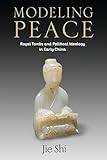Modeling Peace : Royal Tombs and Political Ideology in Early China / Jie Shi.
Material type: TextSeries: Tang Center Series in Early ChinaPublisher: New York, NY : Columbia University Press, [2020]Copyright date: ©2019Description: 1 online resource : 60 photographs, maps, and line drawingsContent type:
TextSeries: Tang Center Series in Early ChinaPublisher: New York, NY : Columbia University Press, [2020]Copyright date: ©2019Description: 1 online resource : 60 photographs, maps, and line drawingsContent type: - 9780231191029
- 9780231549202
- 931 23
- DS797.39.M363 S55 2019
- DS797.39.M363 S55 2019
- online - DeGruyter
- Issued also in print.
| Item type | Current library | Call number | URL | Status | Notes | Barcode | |
|---|---|---|---|---|---|---|---|
 eBook
eBook
|
Biblioteca "Angelicum" Pont. Univ. S.Tommaso d'Aquino Nuvola online | online - DeGruyter (Browse shelf(Opens below)) | Online access | Not for loan (Accesso limitato) | Accesso per gli utenti autorizzati / Access for authorized users | (dgr)9780231549202 |
Browsing Biblioteca "Angelicum" Pont. Univ. S.Tommaso d'Aquino shelves, Shelving location: Nuvola online Close shelf browser (Hides shelf browser)

|

|

|

|

|

|

|
||
| online - DeGruyter Transtopia in the Sinophone Pacific / | online - DeGruyter What Really Counts : The Case for a Sustainable and Equitable Economy / | online - DeGruyter Human Relations Commissions : Relieving Racial Tensions in the American City / | online - DeGruyter Modeling Peace : Royal Tombs and Political Ideology in Early China / | online - DeGruyter Ocean of Milk, Ocean of Blood : A Mongolian Monk in the Ruins of the Qing Empire / | online - DeGruyter Unfree Markets : The Slaves' Economy and the Rise of Capitalism in South Carolina / | online - DeGruyter Beauty in the Age of Empire : Japan, Egypt, and the Global History of Aesthetic Education / |
Frontmatter -- Contents -- List of maps, figures, and table -- Introduction -- PART I -- Chapter One. The Embrace of Body and Soul -- Chapter Two. The Union of Husband and Wife -- Chapter Three. Integration of Ethnic Han and Non-Han -- PART II -- Chapter Four. The Public King -- Chapter Five. The King of Peace -- Chapter Six. The King Under the Gaze -- Conclusion -- Notes -- Bibliography -- Index
restricted access online access with authorization star
http://purl.org/coar/access_right/c_16ec
Among hundreds of thousands of ancient graves and tombs excavated to date in China, the Mancheng site stands out for its unparalleled complexity and richness. It features two juxtaposed burials, of the first king and queen of the Zhongshan kingdom (dated late second century BCE). The male tomb occupant, King Liu Sheng (d. 113 BCE), was sent by his father, Emperor Jing (r. 157-141 BCE), to rule the Zhongshan kingdom near the northern frontier of the Western Han empire, neighboring the nomadic Xiongnu confederation.Modeling Peace interprets Western Han royal burial as a political ideology by closely reading the architecture and funerary content of this site and situating it in the historical context of imperialization in Western Han China. Through a study of both the archaeological materials and related received and excavated texts, Jie Shi demonstrates that the Mancheng site was planned and designed as a unity of religious, gender, and intercultural concerns. The site was built under the supervision of the future royal tomb occupants, who used these burials to assert their political ideology based on Huang-Lao and Confucian thought: a good ruler is one who pacifies himself, his family, and his country. This book is the first scholarly monograph on an undisturbed and fully excavated early Chinese royal burial site.
Issued also in print.
Mode of access: Internet via World Wide Web.
In English.
Description based on online resource; title from PDF title page (publisher's Web site, viewed 02. Mrz 2022)


